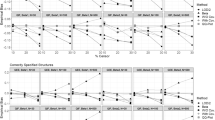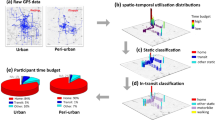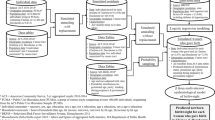Abstract
Everyone is subject to environmental exposures from various sources, with negative health impacts (air, water and soil contamination, noise, etc.or with positive effects (e.g. green space). Studies considering such complex environmental settings in a global manner are rare. We propose to use statistical factor and cluster analyses to create a composite exposure index with a data-driven approach, in view to assess the environmental burden experienced by populations. We illustrate this approach in a large French metropolitan area. The study was carried out in the Great Lyon area (France, 1.2 M inhabitants) at the census Block Group (BG) scale. We used as environmental indicators ambient air NO2 annual concentrations, noise levels and proximity to green spaces, to industrial plants, to polluted sites and to road traffic. They were synthesized using Multiple Factor Analysis (MFA), a data-driven technique without a priori modeling, followed by a Hierarchical Clustering to create BG classes. The first components of the MFA explained, respectively, 30, 14, 11 and 9% of the total variance. Clustering in five classes group: (1) a particular type of large BGs without population; (2) BGs of green residential areas, with less negative exposures than average; (3) BGs of residential areas near midtown; (4) BGs close to industries; and (5) midtown urban BGs, with higher negative exposures than average and less green spaces. Other numbers of classes were tested in order to assess a variety of clustering. We present an approach using statistical factor and cluster analyses techniques, which seem overlooked to assess cumulative exposure in complex environmental settings. Although it cannot be applied directly for risk or health effect assessment, the resulting index can help to identify hot spots of cumulative exposure, to prioritize urban policies or to compare the environmental burden across study areas in an epidemiological framework.
This is a preview of subscription content, access via your institution
Access options
Subscribe to this journal
Receive 6 print issues and online access
$259.00 per year
only $43.17 per issue
Buy this article
- Purchase on Springer Link
- Instant access to full article PDF
Prices may be subject to local taxes which are calculated during checkout



Similar content being viewed by others
References
WHO. Air Quality Guidelines Global Update 2005 Bonn, Germany: WHO Regional Office for Europe; 2005. Available at http://www.who.int/phe/health_topics/outdoorair/outdoorair_aqg/en/index.html.
Barceló MA, Saez M, Saurina C . Spatial variability in mortality inequalities, socioeconomic deprivation, and air pollution in small areas of the Barcelona Metropolitan Region, Spain. Sci Total Environ 2009: 407 (21): 5501–5523.
Brender JD, Maantay JA, Chakraborty J . Residential proximity to environmental hazards and adverse health outcomes. Am J Public Health 2011: 101 (S1): S37–S52.
Passchier-Vermeer W, Passchier WF . Noise exposure and public health. Environ Health Perspect 2000: 108 (Suppl 1): 123–131.
WHO. Guidelines for community noise. 1999. World Health Organization: Geneva, Switzerland: 2008 Available at http://www.who.int/docstore/peh/noise/guidelines2.html.
Mitchell R, Popham F . Greenspace urbanity and health: relationships in England. J Epidemiol Community Health 2007: 61 (8): 681–683.
Maas J, Verheij RA, de Vries S, Spreeuwenberg P, Schellevis FG, Groenewegen PP Morbidity is related to a green living environment. J Epidemiol Community Health. 2009: 63 (12): 967–973.
Callahan MA, Sexton K . If cumulative risk assessment is the answer, what is the question? Environ Health Perspect 2007: 115 (5): 799–806.
Pearce JR, Richardson EA, Mitchell RJ, Shortt NK . Environmental justice and health: a study of multiple environmental deprivation and geographical inequalities in health in New Zealand. Social Sci Med 2011: 73: 410–420.
Sexton K . Cumulative risk assessment: an overview of methodological approaches for evaluating combined health effects from exposure to multiple environmental stressors. Int J Environ Res Public Health 2012: 9 (12): 370–390.
Alves S, Tilghman J, Rosenbaum A, Payne-Sturges DC . U.S. EPA authority to use cumulative risk assessments in environmental decision-making. Int J Environ Res Public Health 2012: 9 (6): 1997–2019.
U.S. EPA. Framework for Cumulative Risk Assessment. U.S. Environmental Protection Agency: Washington DC, 2003 mai. Report No.: EPA/630/P02/001F. Available at http://www.epa.gov/raf/publications/framework-cra.htm.
California Environmental Justice Action Plan. Environmental Justice Action Plan. Cal-EPA 2004 oct. Available at http://www.calepa.ca.gov/EnvJustice/ActionPlan/Documents/October2004/ActionPlan.pdf.
Commission of the European Communities. The European Environment & Health Action Plan 2004-2010 COM(2004) 416 final. Commission of the European Communities; 2004. Available at http://eur-lex.europa.eu/LexUriServ/LexUriServ.do?uri=CELEX:52004DC0416:EN:HTML.
National Research Council (U.S.). Science and decisions advancing risk assessment. National Academies Press: Washington, DC, USA 2009.
Su JG, Morello-Frosch R, Jesdale BM, Kyle AD, Shamasunder B, Jerrett M . An index for assessing demographic inequalities in cumulative environmental hazards with application to Los Angeles, California. Environ Sci Technol. 2009: 43 (20): 7626–7634.
Richardson EA, Mitchell R, Shortt NK, Pearce J, Dawson TP . Developing summary measures of health-related multiple physical environmental deprivation for epidemiological research [Abstract only]. Environ Planning A 2010: 42 (7): 1650–1668.
Yorita Christensen KL, White P . A methodological approach to assessing the health impact of environmental chemical mixtures: PCBs and hypertension in the National Health and Nutrition Examination Survey. Int J Environ Res Public Health 2011: 8 (11): 4220–4237.
Huang G, London JK . Cumulative environmental vulnerability and environmental justice in California’s San Joaquin Valley. Int J Environ Res Public Health 2012: 9 (5): 1593–1608.
INSEE. Institut national de la statistique et des études économiques. Available at http://www.insee.fr.
Soulhac L, Salizzoni P, Cierco F-X, Perkins R . The model SIRANE for atmospheric urban pollutant dispersion; part I, presentation of the model. Atmos Environ 2011: 45 (39): 7379–7395.
Soulhac L, Salizzoni P, Mejean P, Didier D, Rios I . The model SIRANE for atmospheric urban pollutant dispersion; PART II, validation of the model on a real case study. Atmos Environ 2012: 49: 320–337.
Padilla CM, Deguen S, Lalloue B, Blanchard O, Beaugard C, Troude F et al. Cluster analysis of social and environment inequalities of infant mortality. A spatial study in small areas revealed by local disease mapping in France. Sci Total Environ. 2013: 454–455: 433–441.
European Parliament and European Council. Directive 2008/50/EC of the European Parliament and of the Council of 21 May 2008 on ambient air quality and cleaner air for Europe. Official Journal of the European Communities 2008.
European Parliament and European Council. Directive 2002/49/EC of the European Parliament and of the Council of 25 June 2002 relating to the assessment and management of environmental noise. Official Journal of the European Communities 2002.
Kihal-Talantikite W, Padilla CM, Lalloue B, Rougier C, Defrance J, Zmirou-Navier D et al. An exploratory spatial analysis to assess the relationship between deprivation, noise and infant mortality: an ecological study. Environ Health 2013: 12 (1): 109.
E-PRTR - The European Pollutant Release and Transfer Register. Available at http://prtr.ec.europa.eu/.
Basias - Inventaire historique de sites industriels et activités de service. Available at http://basias.brgm.fr/.
ESRI ADDG. ArcGIS 9.1. The complete geographic information system 2005.
Kihal-Talantikite W, Padilla CM, Lalloué B, Gelormini M, Zmirou-Navier D, Deguen S . Green space, social inequalities and neonatal mortality in France. BMC Pregnancy Childbirth 2013: 13 (1): 191.
Lebart L, Morineau A, Warwick KM . Multivariate Descriptive Statistical Analysis: Correspondence Analysis and Related Techniques for Large Matrices. Wiley: New York, NY, USA, 1984.
Lalloué B, Monnez J-M, Padilla C, Kihal W, Le Meur N, Zmirou-Navier D et al. A statistical procedure to create a neighborhood socioeconomic index for health inequalities analysis. Int J Equity Health 2013: 12 (1): 21.
Escofier B, Pagès J . Multiple factor analysis (AFMULT package). Comput Stat Data Anal 1994: 18 (1): 121–140.
R Core Team. R: A Language and Environment for Statistical Computing [Internet]. R Foundation for Statistical Computing: Vienna, Austria, 2013 Available at http://www.R-project.org/.
Lê S, Josse J, Husson F . FactoMineR: an R package for multivariate analysis. J Stat Software 2008: 25 (1): 1–18.
O’Neill MS, Jerrett M, Kawachi I, Levy JI, Cohen AJ, Gouveia N et al. Health, wealth, and air pollution: advancing theory and methods. Environ Health Perspect 2003: 111 (16): 1861–1870.
Sexton K, Hattis D . Assessing cumulative health risks from exposure to environmental mixtures - three fundamental questions. Environ Health Perspect 2007: 115 (5): 825–832.
Menzie CA, MacDonell MM, Mumtaz M . A phased approach for assessing combined effects from multiple stressors. Environ Health Perspect 2007: 115 (5): 807–816.
Billionnet C, Sherrill D, Annesi-Maesano I . Estimating the health effects of exposure to multi-pollutant mixture. Ann Epidemiol 2012: 22 (2): 126–141.
Benmarhnia T, Laurian L, Deguen S . Measuring spatial environmental deprivation: a new index and its application in France. Environ Justice 2013: 6 (2): 48–55.
Greenland S, Morgenstern H . Ecological bias, confounding, and effect modification. Int J Epidemiol 1989: 18 (1): 269–274.
Shortt NK, Richardson EA, Pearce J, Mitchell RJ . Mortality inequalities by environment type in New Zealand. Health Place 2012: 18 (5): 1132–1136.
Deguen S, Lalloué B, Bard D, Havard S, Arveiler D, Zmirou-Navier D . A small-area ecologic study of myocardial infarction, neighborhood deprivation, and sex: a Bayesian modeling approach. Epidemiology 2010: 21 (4): 459–466.
Acknowledgements
This work and the Equit’Area project are supported by the French National Research Agency (ANR, contract-2010-PRSP-002-01) and the EHESP School of Public Health. This research was also jointly supported by the Direction Générale de la Santé (DGS), the Caisse Nationale d’Assurance Maladie des Travailleurs Salariés (CNAMTS), the Régime Social des Indépendants (RSI), the Caisse Nationale de Solidarité pour l’Autonomie (CNSA), the Mission Recherche de la Direction de la Recherche, des Etudes, de l’Evaluation et des Statistiques (MiRe-DREES) and l’Institut national de prévention et de promotion de la santé (Inpes), under the research call launched by the French Institute of Public Health Research (IReSP) in 2010.
Author information
Authors and Affiliations
Corresponding author
Ethics declarations
Competing interests
The authors declare no conflict of interest.
Additional information
Supplementary Information accompanies the paper on the Journal of Exposure Science and Environmental Epidemiology website
Rights and permissions
About this article
Cite this article
Lalloué, B., Monnez, JM., Padilla, C. et al. Data analysis techniques: a tool for cumulative exposure assessment. J Expo Sci Environ Epidemiol 25, 222–230 (2015). https://doi.org/10.1038/jes.2014.66
Received:
Revised:
Accepted:
Published:
Issue Date:
DOI: https://doi.org/10.1038/jes.2014.66
Keywords
This article is cited by
-
Environmental and social inequities in continental France: an analysis of exposure to heat, air pollution, and lack of vegetation
Journal of Exposure Science & Environmental Epidemiology (2024)
-
A multivariate analysis of CalEnviroScreen: comparing environmental and socioeconomic stressors versus chronic disease
Environmental Health (2017)



